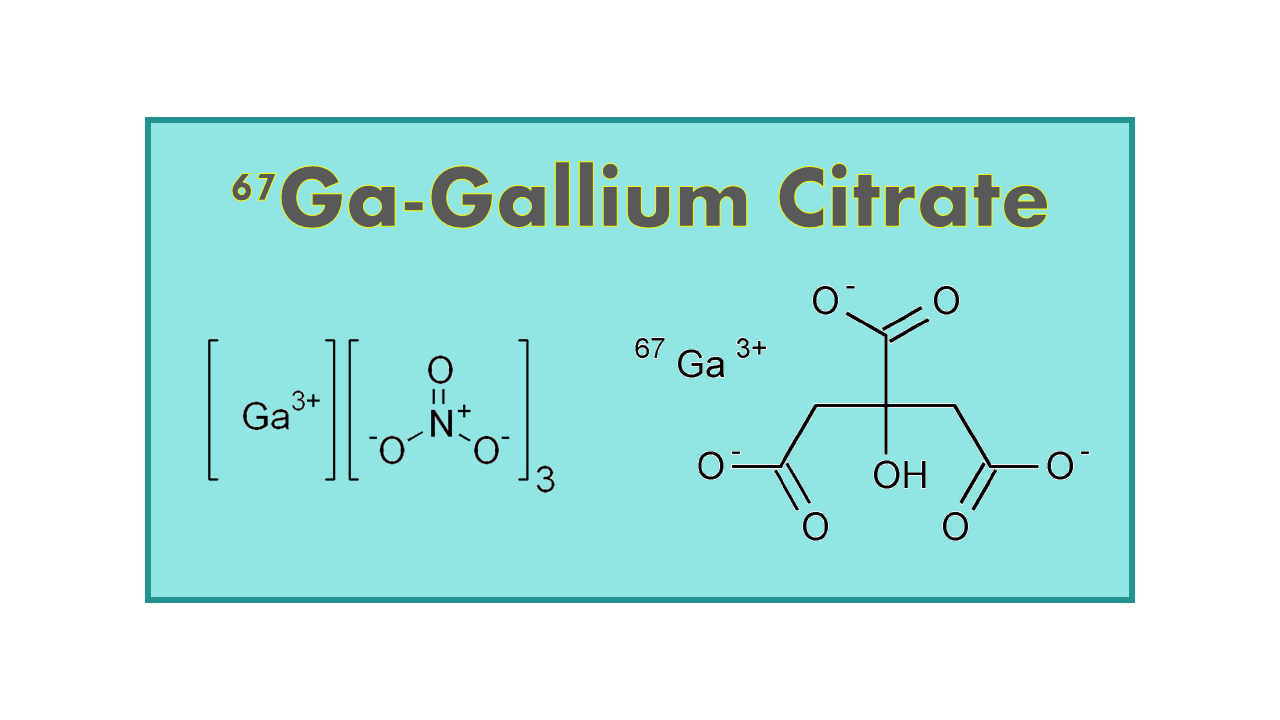
67Ga-Gallium Citrate and Nitrate
March 3, 2024
67Ga-Gallium citrate is a radiopharmaceutical used in nuclear medicine imaging procedures, particularly for detecting and localizing infections, inflammation, and tumors in the body. It is a gamma-emitting isotope of Gallium that is typically bound to citrate for injection.
Gallium citrate is administered intravenously, and it accumulates in areas of increased metabolic activity, such as infection sites or tumor cells. The gamma emissions from 67Ga can be detected by a SPECT (single-photon emission computed tomography) scanner, allowing for the visualization and localization of the underlying pathology.
This radiopharmaceutical has a relatively short half-life of about 78 hours, which allows for imaging procedures to be performed within a few days of administration without prolonged radiation exposure to the patient.
67Ga-Gallium citrate imaging is particularly useful in diagnosing certain types of lymphomas, inflammatory diseases, and some types of cancer. It provides valuable information to clinicians for treatment planning and monitoring the response to therapy.
Overall, 67Ga-Gallium citrate imaging is a valuable tool in nuclear medicine for the diagnosis and management of various medical conditions, providing non-invasive and detailed information about the physiological processes occurring in the body.
Description
67Ga Gallium salts (Citrate or Nitrate) are older SPECT imaging agents still in use for general imaging purposes. The form of salt is not important, since it is the freely dissolved gallium ion Ga3+ which is active. The chemistry of gallium is similar to iron and therefore, gallium salts can be used as tracers in biological processes where iron plays a major role. The gallium used in these protocols is no carrier added and these same 67Ga salts can be used for labeling of organic molecules.
Clinical applications
67Ga plays a role in the imaging of infection, and imaging of acute inflammatory lesions, although it is a non-specific agent. Typical dose is in the range 3-7 mCi. The 67Ga scan has an advantage over 111In leukocyte imaging (111In white blood cell scan) in imaging osteomyelitis (bone infection) of the spine, lung infections and inflammation, and for chronic infections.
67Ga has a role to play in the diagnosis of pyrexia (fewer) of unknown origin (PUO or FUO). 67Ga is useful to demonstrate the presence and extension of Hodgkin’s disease and Lymphoma. In tumor imaging, 67Ga is used in the diagnosis of bronchogenic carcinoma, hepatocarcinoma, large melanomas, mesothelioma, soft tissue sarcoma or seminoma. The typical dose of 67Ga is 10 mCi for neoplasms and imaging takes place at 48–72 hours, which is possible due to the long half-life of the radionuclide.
No carrier added 67Ga needs to be used in these protocols as significant amounts of cold gallium changes its biologic distribution, resulting in increased concentration in the skeleton.
Availability and price
The most important producers of radionuclides that have access to a high-energy cyclotron, produce and sell pharmaceutical grade 67Ga salts. Most of the available products are based on 67Ga Citrate: CISbio/IBA Molecular (Ga-67-MM-1®, EU MA new formulation December 2011), Fuji-Film (Gallium Citrate Ga-67), GE Healthcare (Neoscan®, MA obtained in December 1977; EU MA 1998, discontinued), Lantheus (US MA May 1976, originally under the name Dupont GA-67; BMS EU MA November 1997, discontinued), Mallinckrodt (Curium) (US MA February 1979, EU MA 1998), Nordion or Isotope Russia, Nihon Medi System (Gallium Citrate). The competition has led to very low prices for this tracer. Shelf-life is about 14 days.
Pharmaceutical grade 67Ga salts are available at prices around US$200/mCi in the US. In 2020 in the USA, a dose of Gallium citrate is charged around US$ 130-140.
Competition
99mTc-Sulfur colloids and 201Tl-Thallium chloride can for some indications either compete or substitute for 67Ga salts, but both are also non-specific tracers. Dual imaging with 99mTc Sulfur Colloids is performed to improve liver cancer diagnostic.
The major competition comes from the development of PET and the availability of 18F- FDG.
Comments
For its broad applications, some physicians consider 67Ga as the “poor man’s FDG”. In fact, in the past, the gallium scan was the gold standard for cancer diagnosis and staging, until it was replaced by PET using FDG. Note that all the above indications could easily be performed with 68Ga salts from 68Ge/68Ga generators and provide the same level of diagnosis probably with a better image quality. 68Ga salts would however, not be more specific than 67Ga salts. 68Ga does not have any marketing authorization for any of these indications.
Interest for 67Ga is now fading, but due to the incomplete coverage of PET cameras and still limited access to 18F-FDG, as well as the lower price of 67Ga compared to 18F, 67Ga continues to be used in a regular way by some nuclear medicine centers.